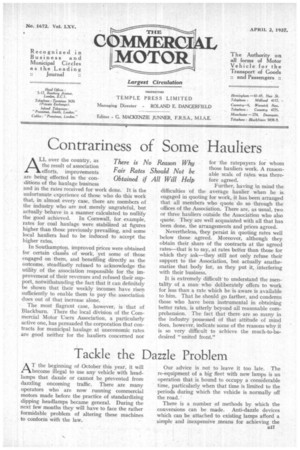Tackle the Dazzle Problem
Page 31

Page 32

If you've noticed an error in this article please click here to report it so we can fix it.
AA T the beginning of October this year, it will ..tbecome illegal to use any vehicle with headlamps that dazzle or cannot be prevented from dazzling oncoming traffic. There are many operators who are now running commercial motors made before the practice of standardizing dipping headlamps became general. During the next few months they will have to face the rather formidable problem of altering these machines to conform with the law. Our advice is not to leave it too late. The re-equipment of a big fleet with new lamps is an operation that is bound to occupy a considerable time, particularly when that time is limited to the periods during which the vehicle is normally off the road. '
There is a number of methods by which the conversions can be made. Anti-dazzle devices which can be attached to existing lamps afford a simple and inexpensive :means for achieving the desired end. Possible disadvantages of these, however, are that they may diminish the intensity of the light, restrict the width of the beam emitted, or fail in their main object uncller certain conditions.
The scheme which will probably come first to the minds of most operators is to install a new dipping light, together with an operating switch that simultaneously extinguishes the other lamp. This is a satisfactory arrangement, but in thin traffic it is an effort and a distraction constantly to be dipping, whilst on busy trunk routes the lamp will be dipped for most of the time, and consequently functioning, as a projector, at reduced efficiency. Nevertheless, a good "gutter" light enables speeds of over 30 m.p.h. to be maintained with safety in the face of approaching lights and even in bad circumstances such as are caused by black, wet roads and poor visibility.
It cannot be disputed, however, that this plan is far from ideal. Nearer to perfection is the lamp expressly designed normally to throw light, without wastage, in such a manner that no one is dazzled, yet the road ahead, at the sides and in the distance, is as well illuminated as with the conventional glaring headlamp. Such lamps are obtainable; they flood the surface of the highway with, as it were, a carpet of light; stretching far ahead, but never rising to the statutory 3-ft. 6-in. eye level.
With the weekly addition of 500 vehicles to our roads, every possible measure for facilitating night driving should be taken. A long-sighted vision is demanded, and equipment that is serving well enough the needs of the present may not be the best for the more exacting requirements of the future. Money wisely invested in first-class lighting equipment will result in more dependable and faster running and greater freedom from accidents.
Transport Services in War Time
AVALUABLE memorandum dealing with the vitally important subject of the maintenance of effective transport communications in the event of this country being involved in a big war has been prepared by the National Road Transport Employers Federation, and has been sent to the Ministers of War and Transport.
It points out that although the Federation represents the interests of hauliers, the memorandum is in no sense a contribution to the road-rail controversy, but merely a moderate review of the steps considered necessary to ensure an adequate supply of suitable transport.
The first essential is that effective alternative transport facilities should be available, as it would be foolish to rely solely either on the railway system, which is particularly vulnerable from the air, or on road transport which, to a great extent, depends upon imported fuel. Each should be adequate to deal with essential traffic during the partial or complete inactivity of the other. Adequacy of rail facilities is assured. Attention must, therefore, be directed to road transport. If the latter is to play an effective part on the home front during war time, an efficient road system is indispensable.
The opinion recently expressed by Sir William Beveridge, that many of the things done now in readiness for war will make a better country in peace, is conspicuously appropriate in connection with the improvement of our road system. The supply of vehicles must be adequate, yet the activities of the long-distance haulier have been severely curtailed, and the number of vehicles exceeding 4 tons unladen has decreased by 24 per cent. since 1933. An effective number of fullpowered long-distarice lorries would be required in war time, and any deficiency would prove a most serious source of weakness.




























































































